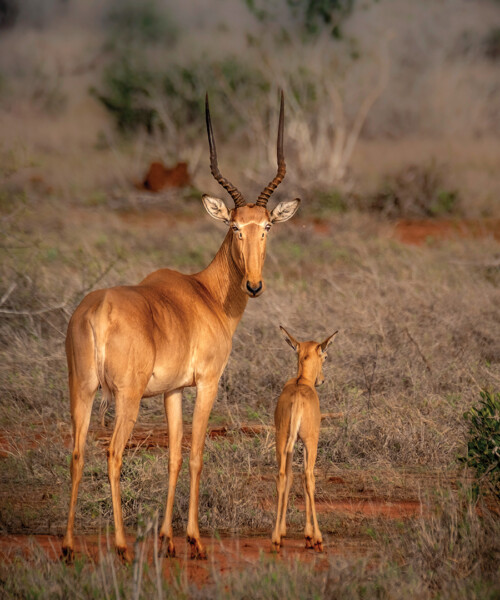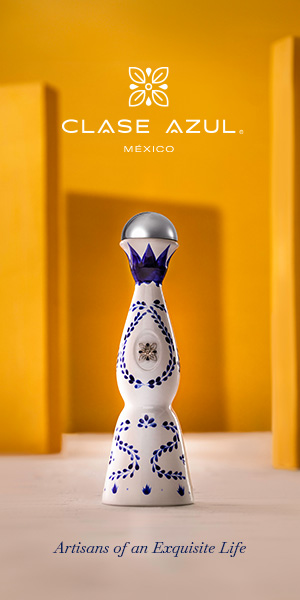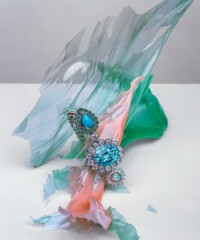Wildlife photographer Dr. Robin Moore knows when to get the perfect shot of skittish, evasive animals that are hard to photograph. For him, time is measured in sunrises and sunsets. Those are the golden hours when soft, filtered light can bring out the gleam in an animal’s eye and the subtle striations in its fur. That, of course, is assuming the subject goes where you want.
On an October 2019 trip to Kenya, Moore had just five short tropical sunrises and sunsets—about two hours total—to find and photograph the hirola, a critically endangered antelope. There are less than 500 hirola left, all of them in the country’s southeastern corner. Once 16,000 strong before a devastating rinderpest outbreak in the 1980s, the hirola is the only surviving member of its genus. Its loss would be the first extinction of a genus on the African continent since the evolution of modern man.

A ranger from Tsavo Trust helps look for hirola during the few hours of soft light.
Following the Kenya Wildlife Service’s National Hirola Recovery and Action Plan, The Tsavo Trust and Northern Rangelands Trust plan to build a new hirola sanctuary in the Tsavo East National Park and to double the size of an existing space within the Ishaqbini Community Conservancy. And that’s where Global Wildlife Conservation (GWC) comes in: to help their partners raise the funds needed for these essential projects.
Photos are powerful tools for fundraising, as they help people make an emotional connection with animals, but there were few quality close-ups of the notoriously evasive hirola. “Today, the main threats to the hirola are predation and poaching,” says Moore. “Those who’ve survived have survived for a reason—they are very wary and good at making themselves scarce. They are probably the most skittish animal I’ve ever photographed.”

There are fewer than 500 hirola left, all of them in Kenya’s southeastern corner.
To make matters more complicated, just 70 hirola live in the 5,300-square-mile Tsavo East National Park, where Moore was on assignment. They tend to travel in small groups of about five animals, blending into the landscape of red dirt and dry brush.
So, how did Moore manage to capture not just any shot, but an intimate portrait of a mom and baby? Moore got some advance scouting help from Dr. Barney Long, GWC’s senior director of species conservation. As he toured the park, Moore took note of the lighting, the landscape’s coloring and any eyesores to avoid in the background— all useful intel that would help him plan his shoot. “They would see a hirola about a mile away in the distance,” Moore says. “I’d say, ‘How do you know that’s a hirola?’ They just knew.” The plan was to get close enough to capture details like the hirola’s distinct undereye scent glands, but not too close that they’d scare them away.

Rangers from Tsavo Trust have a keen eye for Hirola and other species that can be tricky to spot.
After getting a lot of shots of the magic animal running away, Moore noticed a pattern. Often, the hirola would start to run, then stop and look around before sprinting away, almost like an indecisive squirrel crossing the road. So when the group encountered a mother and her calf, Moore was ready. The pair started walking away, and when they paused to look back for a couple of seconds, Moore made eye contact and got his stunning portrait.
“When I first saw the hirola in the wild, I was shocked by how stunningly beautiful they were,” says Long. “They’re this gorgeous shade of chestnut brown, striking in this understated way. Once people understand the hirola’s beauty, hopefully they’ll feel compelled to support them.”

Ranger from Tsavo Trust.
Of course, the hirola is more than a pretty face and a shiny coat. It’s a uniquely resilient species. Unlike more well-known animals that can be found across Africa, the hirola has stayed put and adapted to southeastern Kenya’s harsh, arid climate.
“The hirola is kind of a specialist, where other animals are generalists,” Long chuckles. “I use a sports analogy to describe it. Billions of people watch football [soccer], and it’s on all the time. But every four years during the Olympics, we find ourselves discovering and cheering for these cool, niche sports like luge or curling. We need to champion our specialists!”
The hirola’s deep local roots have endeared it to the community. The Ishaqbini fenced sanctuary is located within a completely community-managed conservancy, complete with a warden and an antipoaching group, and the push to double the sanctuary’s size came from the community. And Tsavo East is in a government-run national park. “We have the stakeholder and government support to save the hirola,” Long says. “Now we just need the funds. We can’t lose a whole genus because of money.”







































